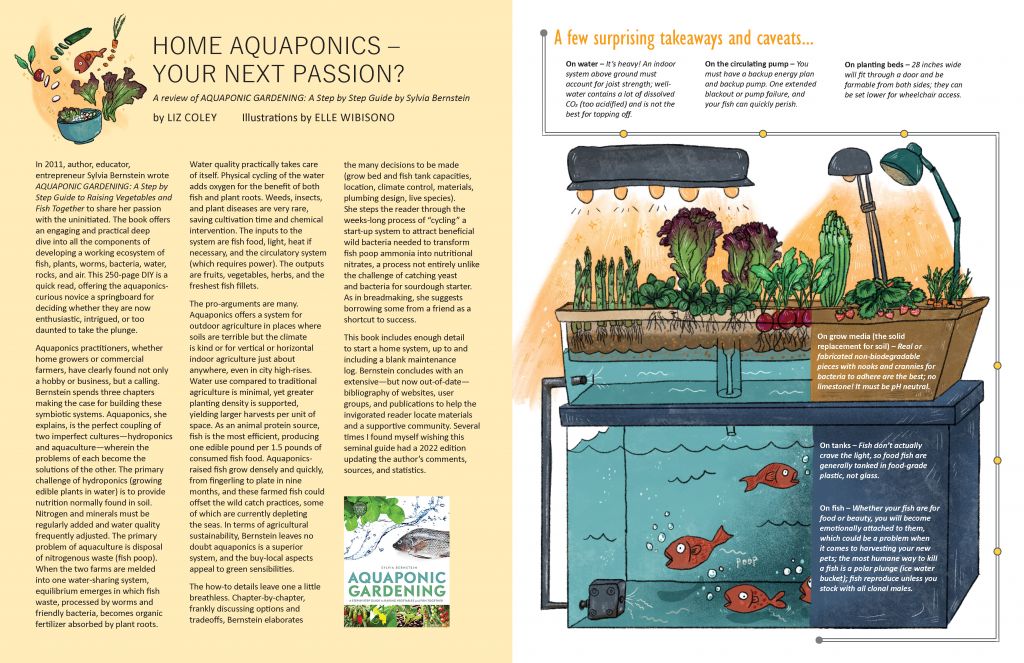In 2011, author, educator, entrepreneur Sylvia Bernstein wrote AQUAPONIC GARDENING: A Step by Step Guide to Raising Vegetables and Fish Together to share her passion with the uninitiated. The book offers an engaging and practical deep dive into all the components of developing a working ecosystem of fish, plants, worms, bacteria, water, rocks, and air. This 250-page DIY is a quick read, offering the aquaponics-curious novice a springboard for deciding whether they are now enthusiastic, intrigued, or too daunted to take the plunge.
Aquaponics practitioners, whether home growers or commercial farmers, have clearly found not only a hobby or business, but a calling. Bernstein spends three chapters making the case for building these symbiotic systems. Aquaponics, she explains, is the perfect coupling of two imperfect cultures—hydroponics and aquaculture—wherein the problems of each become the solutions of the other. The primary challenge of hydroponics (growing edible plants in water) is to provide nutrition normally found in soil. Nitrogen and minerals must be regularly added and water quality frequently adjusted. The primary problem of aquaculture is disposal of nitrogenous waste (fish poop). When the two farms are melded into one water-sharing system, equilibrium emerges in which fish waste, processed by worms and friendly bacteria, becomes organic fertilizer absorbed by plant roots. Water quality practically takes care of itself. Physical cycling of the water adds oxygen for the benefit of both fish and plant roots. Weeds, insects, and plant diseases are very rare, saving cultivation time and chemical intervention. The inputs to the system are fish food, light, heat if necessary, and the circulatory system (which requires power). The outputs are fruits, vegetables, herbs, and the freshest fish fillets.
The pro-arguments are many. Aquaponics offers a system for outdoor agriculture in places where soils are terrible but the climate is kind or for vertical or horizontal indoor agriculture just about anywhere, even in city high-rises. Water use compared to traditional agriculture is minimal, yet greater planting density is supported, yielding larger harvests per unit of space. As an animal protein source, fish is the most efficient, producing one edible pound per 1.5 pounds of consumed fish food. Aquaponics-raised fish grow densely and quickly, from fingerling to plate in nine months, and these farmed fish could offset the wild catch practices, some of which are currently depleting the seas. In terms of agricultural sustainability, Bernstein leaves no doubt aquaponics is a superior system, and the buy-local aspects appeal to green sensibilities.
The how-to details leave one a little breathless. Chapter-by-chapter, frankly discussing options and tradeoffs, Bernstein elaborates the many decisions to be made (grow bed and fish tank capacities, location, climate control, materials, plumbing design, live species). She steps the reader through the weeks-long process of “cycling” a start-up system to attract beneficial wild bacteria needed to transform fish poop ammonia into nutritional nitrates, a process not entirely unlike the challenge of catching yeast and bacteria for sourdough starter. As in breadmaking, she suggests borrowing some from a friend as a shortcut to success.
This book includes enough detail to start a home system, up to and including a blank maintenance log. Bernstein concludes with an extensive—but now out-of-date—bibliography of websites, user groups, and publications to help the invigorated reader locate materials and a supportive community. Several times I found myself wishing this seminal guide had a 2022 edition updating the author’s comments, sources, and statistics.
Browse Ka Pili Kai issues HERE


